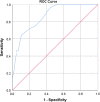COVID-19-associated pulmonary aspergillosis (CAPA): Risk factors and development of a predictive score for critically ill COVID-19 patients
- PMID: 35212030
- PMCID: PMC9115267
- DOI: 10.1111/myc.13434
COVID-19-associated pulmonary aspergillosis (CAPA): Risk factors and development of a predictive score for critically ill COVID-19 patients
Erratum in
-
Erratum.Mycoses. 2022 Nov;65(11):1068. doi: 10.1111/myc.13523. Mycoses. 2022. PMID: 36200178 Free PMC article. No abstract available.
Abstract
Background: COVID-19-associated pulmonary aspergillosis (CAPA) is a major complication of critically ill COVID-19 patients, with a high mortality rate and potentially preventable. Thus, identifying patients at high risk of CAPA would be of great interest. We intended to develop a clinical prediction score capable of stratifying patients according to the risk for CAPA at ICU admission.
Methods: Single centre retrospective case-control study. A case was defined as a patient diagnosed with CAPA according to 2020 ECMM/ISHAM consensus criteria. 2 controls were selected for each case among critically ill COVID-19 patients.
Results: 28 CAPA patients and 56-matched controls were included. Factors associated with CAPA included old age (68 years vs. 62, p = .033), active smoking (17.9% vs. 1.8%, p = .014), chronic respiratory diseases (48.1% vs. 26.3%, p = .043), chronic renal failure (25.0% vs. 3.6%, p = .005), chronic corticosteroid treatment (28.6% vs. 1.8%, p < .001), tocilizumab therapy (92.9% vs. 66.1%, p = .008) and high APACHE II at ICU admission (median 13 vs. 10 points, p = .026). A score was created including these variables, which showed an area under the receiver operator curve of 0.854 (95% CI 0.77-0.92). A punctuation below 6 had a negative predictive value of 99.6%. A punctuation of 10 or higher had a positive predictive value of 27.9%.
Conclusion: We present a clinical prediction score that allowed to stratify critically ill COVID-19 patients according to the risk for developing CAPA. This CAPA score would allow to target preventive measures. Further evaluation of the score, as well as the utility of these targeted preventive measures, is needed.
Keywords: CAPA; COVID-19; critically ill; score.
© 2022 The Authors. Mycoses published by Wiley-VCH GmbH.
Conflict of interest statement
AFC declares personal fees for lectures/presentations/educational events outside the present manuscript. All other authors declare no conflicts of interest.
Figures



References
MeSH terms
LinkOut - more resources
Full Text Sources
Medical

